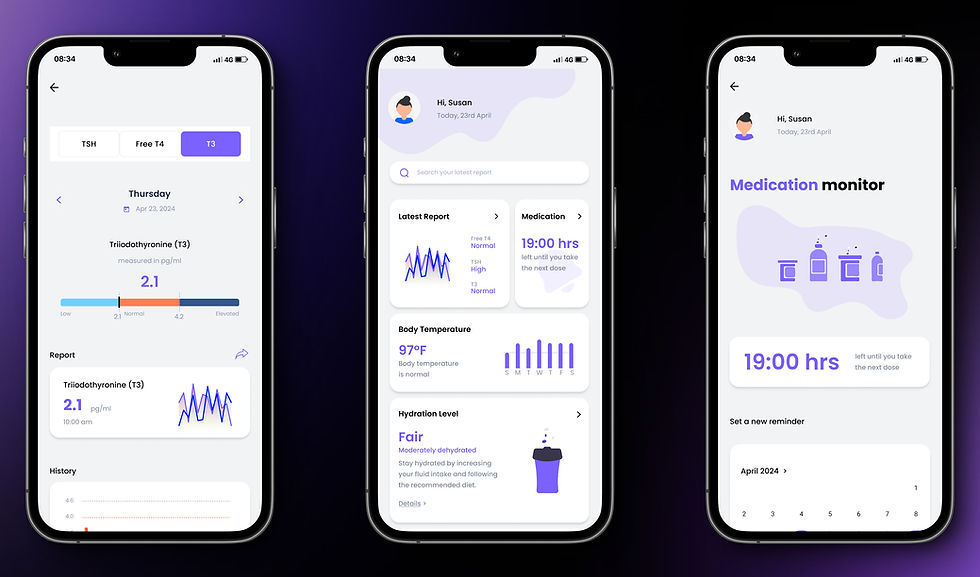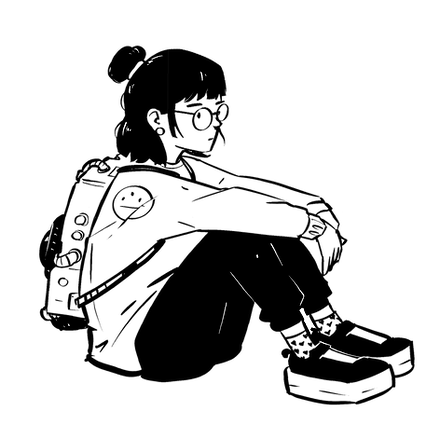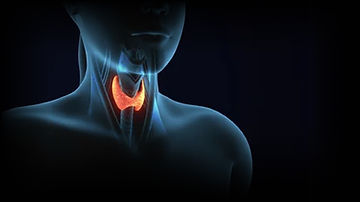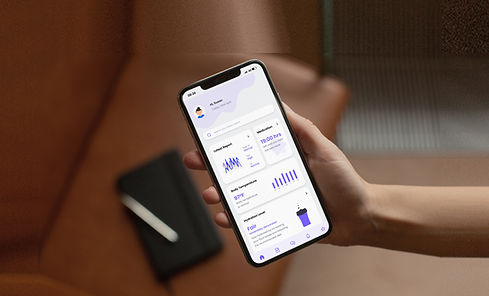
ThyroHealth
A product-service ecology designed for Hypothyroidism patients.
My Role
Product Design User Research Systems Thinking UI/UX Design
Discovery Prototyping
Goal
The goal of this project is to design an integrated system that assists individuals suffering from hypothyroidism by managing their symptoms effectively and promoting a normal, healthy lifestyle. This system will utilize sensors to monitor and maintain hormone levels and dietary habits, thereby helping users manage their condition proactively and live their lives to the fullest.
Duration
4 weeks
Mentor
Jorge Arango
Tools
Figma
Figjam
Photoshop
Overview
Challenge
How might we develop a user-friendly system that enables hypothyroidism patients to effortlessly track and manage their thyroid hormone levels and symptoms, motivating them to enhance their quality of life?
Solution
ThyroHealth enables hypothyroidism patients to monitor their health and share data with healthcare providers.

Hormone Level Screen
Home Screen
Medication Monitor Screen
Impact
ThyroHealth empowers patients with hypothyroidism to take control of their health by enabling them to monitor their thyroid hormone levels, lifestyle, and medication intake, ultimately leading to improved health outcomes and better management of their condition.
Context
Background
What's going on?
Susan, a 29-year-old woman, suffers from hypothyroidism, a condition that requires regular monitoring and management of thyroid levels. Currently, she relies on lab testing, which often involves waiting several days for results. This delay makes it difficult for her to respond promptly to fluctuations in her thyroid levels. Additionally, Susan struggles to maintain a consistent medication routine, frequently forgetting whether she has taken her daily dose.
Problem
What needs fixing?
Susan needs a solution that enables real-time monitoring of her thyroid levels, allowing her to make immediate adjustments to her treatment as needed. She also requires a system to help track her medication intake and lifestyle habits, ensuring a consistent and effective approach to managing her hypothyroidism.

Susan
What is Hypothyroidism?
Hypothyroidism also referred to as an underactive thyroid, is a condition that develops when the thyroid gland doesn't produce enough thyroid hormone .
Role of thyroid hormones:
Regulates many bodily functions, including metabolism, heart rate, and body temperature.

Thyroid gland
1 in 8 women suffer from Hypothyroidism
Causes
Underactive thyroid gland, which leads to insufficient production of thyroid hormones.
Symptoms
Weight gain, muscle weakness, memory problem, fatigue Fatigue and sensitivity to cold.
Medication
Levothyroxine (synthetic thyroid hormone) for the hormone replacement therapy.
How do patient currently regulate the symptoms?
Treatment
Levothyroxine Medicine intake which depends on blood test results and clinical response.

Management
Lifestyle (diet, exercise, sleep) and medication style plays an important role.
Diagnosis
Blood tests to measure levels of thyroid-stimulating hormone (TSH), thyroxine (T4) and Triiodothyronine (T3)
Patient's Journey
Understanding this issue through a systems lens meant considering all the interconnected pieces in Susan's (hypothyroidism patient) life. I mapped out her social networks, the functions of the human body, and how they influence each other through diagrams, journey maps, and feedback loops. Here are some of those visualizations.

Family
Doctor
Friends
Susan's Caregiving Network

Day in the Life of Susan
Energy level
Wake up
Eat breakfast
Work
Takes her Levothyroxine medication on an empty stomach with a glass of water.
Breakfast of oatmeal with berries and nuts for sustained energy.
Experiences brain fog (difficulty concentrating) at times. She takes short walks during breaks to improve focus.
7:00 AM
8:00 AM
5:00 PM
8:00 PM
Low energy (Tired)
Calm
Alert
Active
Super Energetic
6:00 AM
Takes another dose of medication (prescribed multivitamin) and reads before bed to unwind.
Another dose of Medication
Time
Insights from Susan's Journey Mapping
Medication
Consistent medication intake is crucial for managing thyroid hormonal level.
Exercise
Regular physical activity helps combat fatigue and improve mood.
Diet
A healthy, balanced diet can improve symptoms and overall well-being.
Stress Management
Techniques like meditation and relaxation can alleviate symptoms.
Support System
Family and healthcare professionals provide invaluable support.
Current Model Feedback Loop
Understanding and creating this diagram helped me decide which areas to focus on to reduce patients' frustrations. It made it clear which issues were most important to address first.


Hypothesis
If a personalized product and service ecosystem is developed for patients with hypothyroidism, enabling them to monitor their thyroid hormone levels, it will empower them to improve their quality of life by facilitating adjustments in their daily routines and promoting a normal lifestyle.

Solution
ThyroHealth is an ecosystem designed to assist patients with hypothyroidism. To use ThyroHealth, you need two components: the ThyroHealth Patch and the ThyroHealth Mobile Application.

ThyroHealth Patch

ThyroHealth Mobile Application
The ThyroHealth Patch acts as a sensor, measuring thyroid hormone levels, hydration levels (linked to dietary habits), and body temperature. The ThyroHealth Mobile Application records this data and helps manage medication and lifestyle.
Mobile Application Design

Homescreen
Displays the latest TSH, T4, and T3 levels
Shows the time remaining until the next medication dose
Provides the patient's body temperature
Indicates the hydration level
Tracks the duration of sleep from the previous night
Monitor Medication Style and Hydration level:
Check the time remaining until the next medication dose.
Set convenient reminders.
Monitor hydration levels and track daily hydration cycles.
Browse recommended diets to maintain hydration.


Measure Thyroid Hormone Level:
The Thyrocase patch transfers data every hour to an application using a microprocessor.
Patients can view all three recommended thyroid hormone levels: TSH, T4, and T3.
They can access the history of these hormone levels.
Patients can share the status with their primary care provider, as recommended by the doctor.
Precautions:
After reviewing the report, the patient can learn about the basic precautions necessary to maintain thyroid hormone levels.

Product Ecology
Product ecology has provided me with a deeper understanding of my product, including the various types of sensors utilized to address each specific issue that I am focusing on.


Solution Feedback Loop
The diagram shows my plan to assist patients with hypothyroidism in improving their well-being by monitoring their health using ThyroHealth.


Note:
While the patient will be informed about the thyroid hormone level, hydration level, and medication intake cycle in order to maintain the hormone level, they will need to take their medication. This medicine cannot be injected directly into the patient's body because the medication dose will be changed every time based on the thyroid level. If it is injected and the hormone level is increased beyond the normal range, that would be dangerous for the patient.
Therefore, the main goal of ThyroHealth is to inform patients about their thyroid level instantly and maintain the level based on the doctor's prescription for medication doses, which could be 25mg, 50mg, or 100mg.
Next Steps
The next steps involve further development of the UI, followed by repeated testing. Additionally, there is an effort to establish a close feedback loop.
Test with diverse user groups to determine if it accurately measures thyroid hormone levels, hydration levels, body temperature, and sleep duration.
Learnings
Through this project, I discovered that building a product is like building a system, where understanding how the parts work together is key.
It became clear that models act as blueprints, while feedback loops make the product dynamic during development.
One key takeaway is that user conceptual models help us design features that align with how users think.
Note: Illustrations for this case study are taken from Figma community.

Systems Class